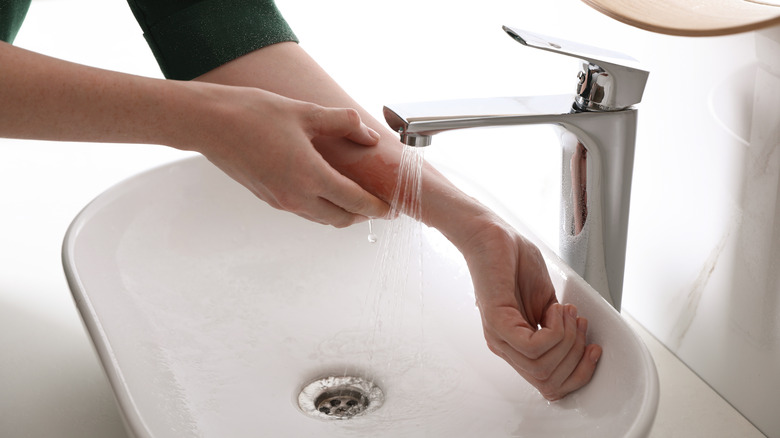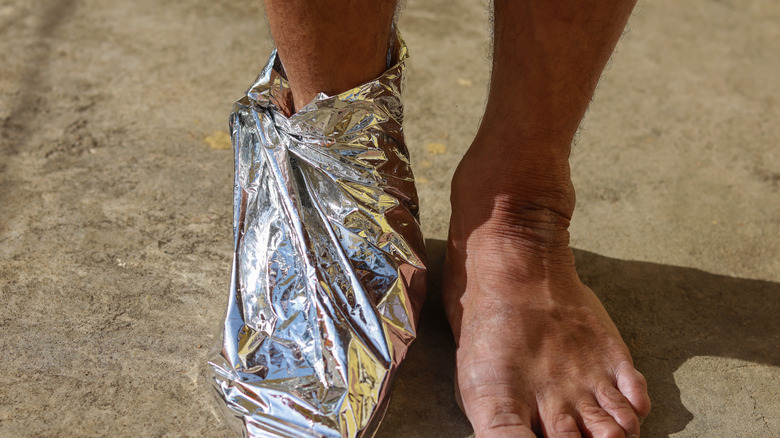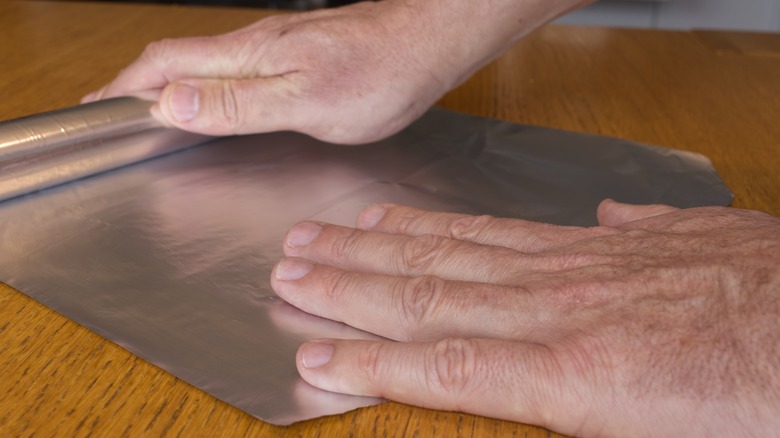Can Aluminum Foil Actually Help Relieve Pain Caused By Burns? What To Consider
While you may have experienced a mild burn when using a curling iron or after briefly touching a hot pan on the stovetop, a number of more serious burns happen every year in the United States. The American Burn Association (ABA) reports that at least 450,000 burn injuries require medical attention annually.
As you may know, even that small curling iron burn can cause a great deal of pain. To help relieve the discomfort, a number of over-the-counter (OTC) topical treatments are available for purchase, such as creams, gels, dressings, and more. Yet some early research suggests that wrapping a burn in aluminum foil can also offer a patient pain relief. This was the case for Frank Mihlan, a firefighter who suffered burn wounds covering nearly three-quarters of his body, as reported via TIME in the summer of 1948. Surgeons at Cleveland's Charity Hospital covered the patient in thin strips of aluminum foil, after which the patient's pain significantly subsided within 20 minutes. After 12 days, Mihlan was up and moving about. It was the first reported instance of aluminum foil being implemented as a burn treatment method in the U.S.
Aluminum foil helps reduce pain by keeping burn wounds dry and healthy
Evidence of aluminum foil therapy for burn wound treatment in the medical community has been identified as early as 1924, according to 2011 research published in Cell and Tissue Banking. Aluminum foil may support patient pain relief in different ways, as studies have shown that using sterilized food-grade aluminum foil as a wound dressing helps protect the injury from crusting as well as bacterial growth. There is also little chance of adverse patient reactions as it is considered non-toxic. Not only that, but experts note that aluminum foil also has the added benefits of being low-cost, readily available, and easily sterilized and applied.
A 1948 study published in The American Journal of Surgery found that the application of aluminum foil to a burn injury also appeared to reduce the maceration of a burn, or the breakdown of skin from prolonged exposure to moisture (via Healthline). The researchers noted that one way in which it did this was by doing away with the need for burn ointments. Skin maceration can also occur due to the body's increased fluid production in response to injury, particularly third-degree burns. In severe cases, skin maceration can be painful. Yet the use of aluminum foil appeared to address this too by dispersing burn-wound fluid to the outer edges of the injury.
Risks of treating burn pain with aluminum foil at home
Alternatively, a 1961 study published in The American Journal of Surgery found that aluminum foil may also offer burn-related pain relief even if the foil isn't applied directly to the wound itself. Rather, by placing aluminum foil underneath a patient, it minimizes the chance of skin sticking to the bed sheets. Layering foil underneath a burn patient when being moved from one location to the operating room was also found to reduce patient pain. The researchers noted that it also reduced the loss of blood and serum in cases of open wound treatment. Fluid loss from the wound was also lessened when wrapping the operating table with foil.
Because most studies regarding aluminum foil treatment for burns have been conducted by medical professionals, there are some potential risks in trying this method at home. Researchers from a 2016 study published in the Journal of Medicine and Life documented their findings in regard to the use of silver, foil-like wound dressings in the prevention of burn scarring. While there were many benefits found, the study team noted that the major downside of this method is that people may not have the knowledge or experience regarding how to apply the dressing properly or how to keep it clean and healthy, such as with regular changings. Therefore, it's always best to seek medical treatment for burn injuries.



